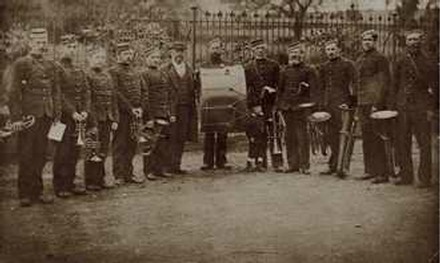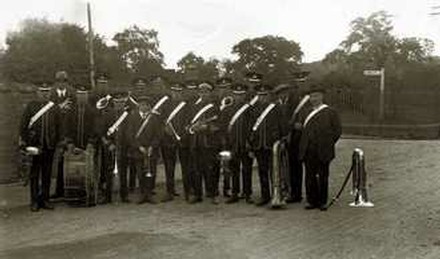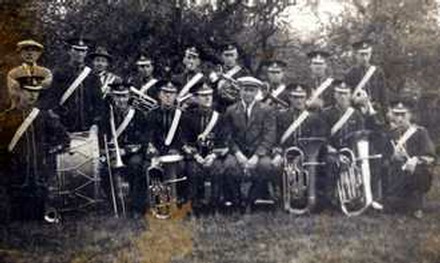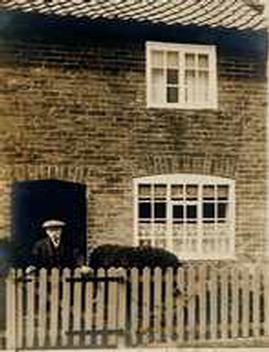Woodborough’s Heritage
Woodborough, a Sherwood Forest Village, recorded in Domesday
Woodborough United Brass Band - 1880 - 1962
1880’s: Village bands were a feature of social life in late Victorian times, before the age of radio and television and when communities made their own amusements. Woodborough's first band was formed in the early 1880’s when Arthur Wylde, a talented musician, was employed at Woodborough Hall as butler and handyman to the Parkyns family. Miss Parkyns recognised his potential and sent him to train for a year at the London School of Music where he was primarily a violinist but took cornet as his second instrument. On his return to Woodborough he became a local music teacher and also formed a village band. Among his pupils were local residents Bernard Wright and Tom Wylde, his nephew, who was the best cornet player of his time. The photograph below of the Woodborough Band dated 1885 is the earliest known.

The Band on Main Street in 1885 with the railings of Governors’ Field behind.
1890’s: During the 1880’s and 1890’s the Band took engagements in Lincolnshire as well as Nottinghamshire, travelling in Jimmie Dunthorne’s carriers cart to Club Feasts at Ancaster, Long Bennington, Caythorpe and Metheringham, and to the Heckington Flower Show. At Long Bennington the Band was once expected to play in the church organ loft but it started to crack under their weight and a hasty exit was made! When Woodborough Cricket Team won the Newark Herald Cup for the third consecutive year in 1885, the Band went to Lowdham station to play them home. Some of the Band members served in the Yeomanry and fought in the Boer war, but this first Band finished in 1901 when Mark Richardson died.
John Richardson - cornet - a framework knitter and choirmaster
Mark Richardson - euphonium - butcher
Joseph Richardson - bass drum - Parish clerk
John Wylde - bass
Arthur Wylde - cornet
Charles Wylde - tenor horn (son of John)
Jarvis Scothern - bass
Samuel Girton - cornet
1911’s: In December 1911 Mr Charles Ernest Foster called a meeting at the Post Office and suggested that several young men of the village were in favour of reviving a village band. Alf Richardson made a particularly stirring speech telling them "it would mean a lot of work and take a deal of time and pluck". Ted Richardson (son of John) proposed that it should be called the Woodborough United Brass Band as it represented all denominations. Mr Ernest Foster was appointed secretary, with William Southern treasurer and the committee included Arthur and Tom Wylde and Billie Richardson (son of John). Four new instruments were bought from Hawkes & Son of London; these included a B flat cornet, E flat tenor horn, B flat baritone horn and an E flat bass. Members of this 1911 Band included:
Alf Richardson – euphonium
William Southern - tenor horn
Ted Richardson (son of John) - E flat bass
Ernest Foster - Secretary
Tom Wylde - cornet
Frank Richardson (son of Alf) - cornet
John Wylde - B flat bass
Alan Wylde - cornet
Billie Richardson (son of John) - side drum
Lewis Snodin - cornet
Bernard Wright - euphonium
Oliver Snodin - trombone
Len Hogg - E flat horn
Jimmie Roe - baritone horn
George Teather - bass drum
Jim Musson - cornet
Nev Ward - cornet
Vernie Savidge - B flat baritone horn
Jack Wright - E flat horn
Johnnie Richardson - B flat cornet (son of John)
Arthur Wylde - Conductor
Ernest Foster was later to recall that "three families in Woodborough could run a brass band on their own with no help from others…". At various times the band included Arthur Wylde, his brother John with sons Charles, Alan and Tom; the Richardson brothers, Mark, Joseph and John senior, his sons Ted, Billie and Johnnie; Alf Richardson senior and his sons Alf junior, Frank and Sam.
At the meeting it was decided to approach Mr Burnett, then owner of the Manor to allow them the use of an upstairs room in the stables for practices and meetings. This was situated to the left of the archway in what is now the Taylor’s Croft building, but at the time they were racing stables.

.jpg)
Above left: Outside Thorneywood House 1912. Above right: Outside the church on Main Street 1921.
Arthur Wylde was a small man and strict with his pupils. His niece, Kate Wylde, later reminisced that at one time he had three pupils from Calverton but would not teach them together because they giggled. Mr Mansfield Parkyns, famous for the carved choir stalls in St. Swithun's church, made a violin for Arthur and carved its head. When Arthur Wylde died this violin was passed on within the family. Arthur Wylde's knowledge and technique were responsible for the first and then later bands in Woodborough. Membership of the first band included two families, one of three brothers (the Richardson's), the other of two brothers and the son of one of them (the Wyldes). The full complement included:
John Richardson - cornet - a framework knitter and choirmaster
Mark Richardson - euphonium - butcher
Joseph Richardson - bass drum - Parish clerk
John Wylde - bass
Arthur Wylde - cornet
Charles Wylde - tenor horn (son of John)
Jarvis Scothern - bass
Samuel Girton - cornet
John Wylde was the father of Charles, Tom (also a cornetist), Alan and Kate who recalls that "he could neither read nor write, yet give him a piece of music and he could read it upside down!"
1910’s: Performances in 1912 and 1913 were used to raise funds for new instruments and for the purchase of uniforms. These events included Whit Monday at Epperstone, Whit Tuesday at Woodborough, garden parties at Lowdham and Gonalston, school treats at Farnsfield and Calverton, Flower Shows at Arnold and Calverton, the Club Feast at Lambley and a party at the Old Manor, Lowdham. Seventeen suits of uniform (navy blue with silver trimmings) were paid for at a cost of £25.10 shillings. The First World War meant the end of the band and at their last meeting "they went to the Four Bells, got two gallons of ale and a bottle of Johnny Walkers and not one of them got home…".
The Band reformed immediately after the war, meeting first at the Bugle Horn and later in a building at the corner of Roe Hill and Field Lane belonging to Frank Richardson but used as a frame store. The room was so small that fourteen was the maximum it could hold, so as the Band grew it moved to The Institute for practice sessions. Members paid a subscription of 1/-, plus 2d weekly towards the cost of lighting and cleaning. In 1919 subscriptions were raised to 2/6d for new members although older members continued to pay only 1/-. New members in 1919 were George, Wilfred and Jimmie Snodin, William Porter, William Wright, Harry Middup, Arthur Binch, Sam Richardson, and Arthur Bardell. Previous members included Tom and Alan Wylde, Jimmy Roe, Oliver Snodin, Alf and Johnnie Richardson, Jack Wright, Ernest Stocks, Lewis Snodin and Len Hogg.
"Mansfield (Mannie) Foster's dad was fascinated with the big drum - he wasn't a tall man, nor was he stout, so if you saw him coming down the street with the drum it looked as if the drum was on its own, with nobody behind it", is one recollection! They would practice in The Institute in winter and marching up and down Main Street in spring and summer. They lined up in fours with five and sometimes six rows. Kate Wylde's father was the smallest in the band but played the biggest instrument (E flat bass) and marched in the front row. "There were drums at the back, bass and side drum, trombones and euphonium, six cornets, two or three second cornets, three tenor horns and a baritone, an E flat and a B flat bass – they were the two big instruments".
1920’s: The Band was kept busy during the Twenties, with many engagements such as local Club Feasts, Primrose League parties, gatherings at Woodborough Hall, Gonalston Hall and Epperstone Manor. Band members recall some notable happenings - "One Whit Tuesday it were ever so hot and the big drum burst as they marched down Baggaley’s drive (the Old Manor)". At Hoveringham Hall "There are two big iron gates with a stop in the middle. The drummer hit his foot on it and rolled over the top, that stopped the Band!" On a visit to Long Bennington "one of the men tried on his uniform but he’d grown a bit and it was rather tight. When they got there they found his trousers had parted, so they borrowed a bodkin and some string, took him into the carrier's van and stitched them on him…".
The Band always played for the Club Feast on Whit Tuesday "we used to go down to Bert Kelk's farm on Shelt Hill to start about 11 o’clock and he always wanted to play 'Lead Kindly Light' to the tune of Sandon and he’d stand there with his red handkerchief crying while we played. Then we'd march on to the New Inn (also on Shelt Hill), play and have us first drink. Next stop the Old Manor, then the Nag's Head where we would stop for an hour before off up to the Bells for lunch about one o’clock. We come out about half past two, up to Paulson’s at Thorneywood for an hour on the tennis court, and then back to the Hall for dancing on the bottom lawn.
Five o’clock time we'd have a tune at Johnny Ball's shop (opposite Park Avenue), then into the Manor where Mannie's (Mansfield Foster) father would try to play the drum on the last bit. Then back to the Band room and we we're all deadbeat". Few of the bandsmen had proper lessons; they just picked it up from others. When a new member went to practices, one of the old hands would sit behind him and keep in time, placing a finger on the music for the player to follow. For practices they would start with a hymn tune "because playing long notes you can tell more quickly if anyone blows out of tune". It also warmed the instruments "they always go better when they get warm and wet".

.jpg)
.jpg)
.jpg)

.jpg)
Above left: 1933 At the Park Right: Above right: 1936 Woodborough Hall
1930’s: By 1931 Frank Richardson had become Bandmaster, with Len Hogg secretary. Subscriptions remained the same and the Institute was hired for 2/- per night, including light and heat.
The following members had instruments issued:
Johnnie Richardson – B flat bass
R. Sorsby – E flat bass
Laurie Robinson – E flat bass
Oliver Snodin – B flat trombone
Sam Richardson – euphonium
Alf Richardson – B flat tenor horn
Bernard Wright – B flat baritone horn
Bert Kelk – E flat tenor horn
Bert Swift – E flat tenor horn
Nev Ward – B flat cornet
George Jephson - B flat cornet
Sam Middup – B flat cornet
E. Wardle – B flat cornet
Fred Musson – bass drum and sticks
Other members at that time were Fred Louth, Ken Chambers, David Cook, Bill Taylor, Bob Hallam and Jim Musson.
Interest began to wane during the thirties and by 1935/6 the accounts showed an income of £10.10.7d and outgoings of £10.5.0d. Some members were getting older and wore dentures. “When you’re banding and wearing dentures it’s difficult”. Sometimes he’d stop and shout “wait”, his dentures would be removed, they’d be covered with Dr Wernet’s Powder, and he’d be alright for another half hour”.
Other members at that time were Fred Louth, Ken Chambers, David Cook (killed in the Second World War), Bill Taylor, Bob Hallam (Hilda’s late husband) and Jim Musson. “I was issued with a new cornet”, remembers Sam [Middup], “but a while later a bandsman came in from away and they took it off me and gave me a dirty old one. I boiled it and boiled it to try and get it clean, but it never played true. So I went to Frank Richardson and said “If you give me a decent instrument, I’ll come back”, but he didn’t, and anyway, soon after that I had my teeth out, it was alright for Johnnie [Richardson] on the bass, but I couldn’t have played cornet with dentures”.
Profits [income] from subscriptions, whist drives and from collections, engagements at Epperstone, Calverton as well as Woodborough. Interest waned during the 1930’s, and accounts for 1935/6 show income of £10 10s 7d and outgoings of £10 5s 0d. Allan [Wright] remembers “When Nev Ward was getting older, he could only see from his left eye, and if you get a music stand that far away, reading glasses are no use, nor are distance glasses. You could get glasses at Woolworths for sixpence, so Nev used to buy half a dozen pairs, and I’ve seen him with as many as three pairs on. After a period without records because Fred Musson made a bonfire in two old ammunition boxes full of music and the minutes of meetings.
1940’s: Another World War reduced the Band's activities again, but there was also a lack of information because two boxes of music and notes of meetings were lost on a bonfire in the early fifties!
1950’s: The following has been taken from the Nottingham Journal dated July 1953. At Woodborough the Coronation was a great occasion—which had been marked in a very special way. For it had brought together once more the old village band—a grandfathers’ band now, said the villagers, but a good one still. They could not play in the open so they sat on forms in the marquee and played “Gone are the days when my heart was young and gay.” Maybe those days had gone for some folk, but certainly not for Bandmaster Frank Richardson as he beat time with one hand and played his cornet with the other. He was a founder member of the old village band in 1910. He is also butcher’s rounds-man for the village.
The village cobbler was there—he played the bass. And some of the old bandsman brought their sons. While Bernard Wright sat and played the trombone his son, David, was nearby playing the cornet. Both are village market gardeners.
Then there was the Ward family. Father Neville Ward, a petroleum worker who plays the cornet. In the band with him were sons Harry and Tom. Harry, an electrician at Calverton Colliery plays the first horn. Tom, a market gardener, plays the kettledrum. Another bass player was 70-year-old Johnnie Richardson, a jobbing gardener. There was contentment in their faces as they rendered their musical salute. Said bandmaster Richardson: “We reformed specially for this occasion, but now we aim to keep together. It’s our first performance since the war.”
There is a report of a meeting in December 1952 at which Allan Wright was elected chairman, Frank Foster secretary and Mannie Foster treasurer. Members included:
.jpg)
Above left: 1953 at the Old Vicarage. Above right: 1953 at Woodborough Hall.
1960’s: The band continued until 1962 when at a meeting in March, it was decided by six votes to one to disband. Alan believes the vote to continue was Frank Richardson’s, and those against probably Alan himself and his father Bernard, Johnnie Richardson, Bert Swift, Nev Ward and Wilf Snodin. Band members, Bernard, Alan and David Wright, Bill Alvey, Frank Foster, Frank Richardson, Fred Musson. Melvyn Foster and Norman Tyler each received £4.10s.0d, and the remaining funds were given to the Over Sixties Club.
“There were plenty of young ones in the band at the end, Norman Tyler, David Wright. Chris Mellows, Melvyn Foster and several more, they just needed someone with some musical knowledge to direct them”, says Sam Middup.
Alan Wright says “We died out for the simple reason that we wanted a young man that could lead. Frank Richardson had been a good bandsman and a good cornet player, but he just got too old. He wanted to be playing the Gay Nineties [1890’s], and we wanted to be playing the Gay Thirties [1930’s]. It’s a tragedy, because we could have carried on, but all the instruments were given to the players. When my father died, we’d got eleven instruments in the house of one sort or another. If anyone wants to start a band again, we’d soon find them some instruments, there’s enough people in the village now. It makes me cross to think I’ve got three grandsons and not one of them plays anything, all they want to do is watch a box [TV]”. There were three generations of Wrights in Woodborough bands, Bernard, his son Alan, and his son David.
Clearly times were changing and young people's interests were being channelled in other directions. The instruments distributed among members and remaining funds given to the Over Sixties Club. At the end "Woodborough's Granddad Band" still had three generations of one family playing, thus living up to the title of Woodborough United Brass Band.
So ended approximately eighty years, with breaks for the two world wars, of the Woodborough Band.
Above left: 1910 Blind Arthur Wylde - Above centre and right: 1925 & 1935 Fred Musson
.jpg)
In June 1953 it was decided to advertise for a trombone and a baritone horn and replace the drum. There were still nineteen members in 1953, with family support also still in evidence. That year advertisements were placed in local papers to obtain replacements for a trombone, tenor horn and drum and there was a reference in the Nottingham Evening Post to "Woodborough's Granddad Band", and we were. In 1958 the big drum needed repair, but it was decided to buy a second-hand one for £14.10.0d and Mannie [Foster] still has the old one, it only wants one side made good and it will be as good as any drum in the Kingdom.
Acknowledgements:
- This text, apart from the last section, has been taken from an unpublished article written by the late Jane Turner and is based on reminiscences of former Band members.
- We also provide here a link to 'The Internet Bandsman's Everything Within' www.ibew.co.uk website, where the reader can learn more about existing, as well as extinct bands.
____________________________________________________________________________________________________
Johnnie Richardson – E flat bass
John Hilgers – E flat bass
Bob White – tenor horn
Melvyn Foster – cornet
Bernard Wright – trombone
Allan Wright – B flat cornet
Oliver Snodin – euphonium
Harry Ward – tenor horn
Harry Hall – bass drum and sticks
Bert Swift – baritone horn
Fred Louth – B flat cornet
Tom (Tucker) Ward – side drum
Sid Snodin – trombone
Bill Alvey – B Flat bass
R. Taylor – tenor horn
Wilf Wright – B flat cornet (Hawkes)
Alf Richardson – tenor horn
Wilfred Snodin – B flat cornet
And Frank Richardson – B flat cornet (Conductor)
Above:1953 The ‘Granddad’ Band marching down Main Street passed the former Co-op store.
| Navigate this site |
| 001 Timeline |
| 100 - 114 St Swithuns Church - Index |
| 115 - 121 Churchyard & Cemetery - Index |
| 122 - 128 Methodist Church - Index |
| 129 - 131 Baptist Chapel - Index |
| 132 - 132.4 Institute - Index |
| 129 - A History of the Chapel |
| 130 - Baptist Chapel School (Lilly's School) |
| 131 - Baptist Chapel internment |
| 132 - The Institute from 1826 |
| 132.1 Institute Minutes |
| 132.2 Iinstitute Deeds 1895 |
| 132.3 Institute Deeds 1950 |
| 132.4 Institute letters and bills |
| 134 - 138 Woodborough Hall - Index |
| 139 - 142 The Manor House Index |
| 143 - Nether Hall |
| 139 - Middle Manor from 1066 |
| 140 - The Wood Family |
| 141 - Manor Farm & Stables |
| 142 - Robert Howett & Mundens Hall |
| 200 - Buckland by Peter Saunders |
| 201 - Buckland - Introduction & Obituary |
| 202 - Buckland Title & Preface |
| 203 - Buckland Chapter List & Summaries of Content |
| 224 - 19th Century Woodborough |
| 225 - Community Study 1967 |
| 226 - Community Study 1974 |
| 227 - Community Study 1990 |
| 400 - 402 Drains & Dykes - Index |
| 403 - 412 Flooding - Index |
| 413 - 420 Woodlands - Index |
| 421 - 437 Enclosure 1795 - Index |
| 440 - 451 Land Misc - Index |
| 400 - Introduction |
| 401 - Woodborough Dykes at Enclosure 1795 |
| 402 - A Study of Land Drainage & Farming Practices |
| People A to H 600+ |
| People L to W 629 |
| 640 - Sundry deaths |
| 650 - Bish Family |
| 651 - Ward Family |
| 652 - Alveys of Woodborough |
| 653 - Alvey marriages |
| 654 - Alvey Burials |
| 800 - Footpaths Introduction |
| 801 - Lapwing Trail |
| 802 - WI Trail |